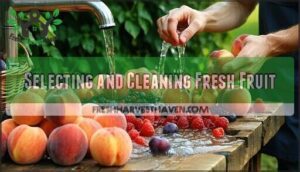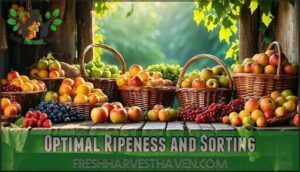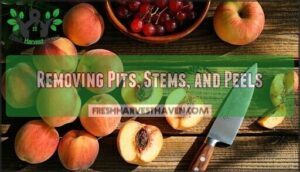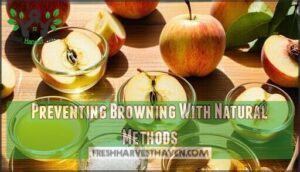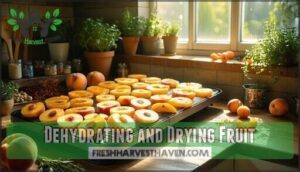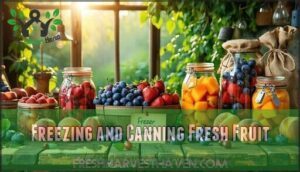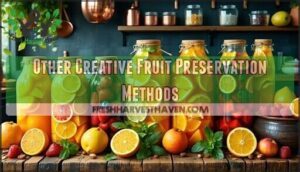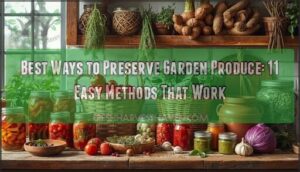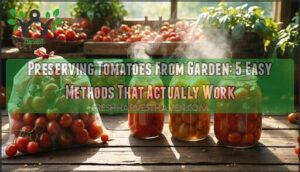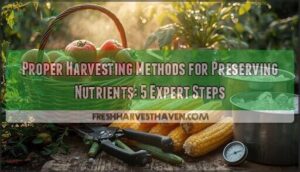This site is supported by our readers. We may earn a commission, at no cost to you, if you purchase through links.
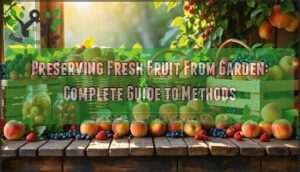 Your garden’s peak harvest season arrives with a beautiful problem: baskets overflowing with ripe peaches, berries bursting with sweetness, and apple trees heavy with fruit—all ripening faster than your family can possibly consume.
Your garden’s peak harvest season arrives with a beautiful problem: baskets overflowing with ripe peaches, berries bursting with sweetness, and apple trees heavy with fruit—all ripening faster than your family can possibly consume.
Within 48 hours, those perfect strawberries develop fuzzy mold, and your carefully tended tomatoes begin their inevitable march toward the compost bin.
The solution lies in mastering preservation techniques that capture your garden’s bounty at its nutritional and flavor peak. Smart preservation methods don’t just extend shelf life; they transform seasonal abundance into year-round nourishment while reducing waste by up to 47%.
Whether you choose dehydrating, freezing, or canning, each technique offers a pathway to food security and the deep satisfaction of preserving fresh fruit from garden to table.
Table Of Contents
- Key Takeaways
- Why Preserve Fresh Garden Fruit?
- Preparing Fruit for Preservation
- Dehydrating and Drying Fruit
- Freezing and Canning Fresh Fruit
- Other Creative Fruit Preservation Methods
- Frequently Asked Questions (FAQs)
- How do you preserve homegrown fruit?
- Can you freeze fresh fruits and vegetables for later use?
- How do you store fruit after harvesting?
- How do farmers keep fruit fresh?
- How to prevent fruit from ripening too quickly?
- Can overripe fruit be preserved effectively?
- Are there eco-friendly preservation technique options?
- How to store fruit safely without refrigeration?
- What tools simplify large-scale fruit preservation?
- When is the best time to harvest fruit?
- Conclusion
Key Takeaways
- Home preservation techniques can reduce fruit waste by up to 47% while maintaining 90% of vitamins and antioxidants when done correctly, far outperforming store-bought alternatives.
- Peak ripeness timing is critical for successful preservation—slightly underripe fruit works best for pickling and fermenting, while perfectly ripe fruit should be frozen or canned immediately.
- Proper preparation prevents failure: thorough cleaning, complete drying, and natural browning prevention with lemon juice or saltwater creates the foundation for safe, long-lasting preserved fruit.
- Different preservation methods serve specific purposes—freezing extends shelf life 8-12 months, dehydrating preserves fruit for up to two years, and water bath canning requires precise temperature control and sterilized equipment for safety.
Why Preserve Fresh Garden Fruit?
When you harvest more fruit than you can eat fresh, you’re left with a choice: watch it spoil or put it to work.
Preserving your garden bounty isn’t just about saving food—it’s about capturing flavor, protecting nutrition, and making the most of your hard work.
Here’s why home preservation matters and what it offers you.
Benefits of Home Fruit Preservation
Home fruit preservation goes beyond simply saving produce—it puts you in complete control of flavor, nutrition, and your family’s food security in ways no grocery store ever could.
This way, you can save peak-season harvests from going to waste while preserving nutrients that commercial processing tends to strip away.
When you handle preservation yourself, you have complete control over every ingredient—you know exactly what went into preserving your harvest, with no unwanted additives or shortcuts.
Fresh storage methods you master today become lasting home economics wisdom.
Reducing Food Waste and Spoilage
Here’s a hard truth about your harvest: nearly half of all fruits and vegetables—44% to be exact—never make it to anyone’s plate. They rot somewhere between farm and table.
This is exactly why learning preservation techniques matters so much—it’s what stands between you and massive food waste.
By implementing proper food storage and shelf life extension methods, you can achieve dramatic results:
- Freezing cuts fruit waste by six times compared to refrigeration alone
- Household preservation can reduce spoilage by 47% through strategic conservation
- Berries develop visible mold within 48–72 hours without protection
- Water content directly determines vulnerability—heartier fruits last months, delicate ones just days
- Every preserved pound means less agricultural water demand and fewer greenhouse emissions
Understanding proper storage techniques is essential for maintaining freshness.
Food preservation transforms your bounty from perishable liability into lasting security.
Nutritional and Flavor Advantages
Preservation doesn’t just rescue fruit from spoilage—it locks in nutrition and taste you won’t find on store shelves. Freeze-dried fruits retain up to 90% of vitamins, antioxidants, and fiber, vastly outperforming canned options. Freezing maintains vitamin C levels better than fresh fruit stored three days in your fridge.
You’re not compromising quality; you’re capturing peak flavor and nutrient density at harvest, delivering antioxidant conservation and vitamin preservation that deteriorates rapidly otherwise. Understanding the freeze drying process is key to preserving nutrients in fruits.
Extending Shelf Life of Harvests
Your carefully preserved fruit won’t do you much good if it spoils in a week—proper techniques can multiply storage time from days into months or even years. Freezing extends shelf life by 8–12 months while preserving nutrients, whereas dehydrating keeps fruit viable for up to two years.
Modified atmosphere storage and postharvest treatments like ethylene absorbers can dramatically slow down ripening and prevent spoilage.
With these food preservation methods, you’ll stop racing against time to eat everything before it goes bad—instead, you can enjoy your harvest throughout the entire year.
Preparing Fruit for Preservation
The foundation of successful preservation starts well before you open a jar or turn on a dehydrator.
Properly preparing your harvest protects both flavor and safety, ensuring your efforts deliver results that last.
Here’s what you need to know to get your fruit ready for any preservation method you choose.
Selecting and Cleaning Fresh Fruit
The moment you pluck a ripe peach or handful of berries from your garden, the clock starts ticking—choosing and washing your fruit the right way can mean the difference between six months of delicious preserves and a batch destined for the compost bin. You’ll want to select fruit at peak ripeness, with indicators specific to each variety, and then treat it with care to prevent bruising during the washing process.
Here’s your essential selection and cleaning workflow:
- Inspect thoroughly: Check for soft spots, mold, or insect damage—even minor flaws can compromise an entire batch during food preservation.
- Use cool, running water: Gently rinse to remove dirt and residues without damaging delicate skins, especially important for organic concerns.
- Pat dry completely: Moisture invites microbial growth, so dry each piece before applying any methods of preservation.
This careful preparation sets the foundation for whichever food preservation techniques you choose next.
Optimal Ripeness and Sorting
Once you’ve washed your harvest, sorting by ripeness becomes your most powerful tool for deciding which fruit goes into the dehydrator today and which can wait another week on the counter. Peak flavor and sugar content align when ripeness indicators—firmness, aroma, color—tell you it’s time. Your texture analysis prevents decomposition and guides which methods of preservation suit each batch.
Sort carefully—your sorting criteria determine success.
| Ripeness Level | Best Use |
|---|---|
| Slightly underripe | Pickling, fermenting |
| Peak ripe | Freezing, canning, immediate dehydrating |
| Overripe | Jams, sauces, quick food storage |
Removing Pits, Stems, and Peels
Clean hands and a sharp paring knife transform whole fruit into ready-to-preserve pieces faster than any gadget—and you’ll keep more flesh intact when you master the basic cuts for each variety. Stone fruit benefits from the twist-and-lift method for pitting techniques, while berries need only gentle stem removal.
Peeling methods vary: blanch peaches for slip-skin ease, use a Y-peeler for apples.
Smart tool selection and waste reduction maintain quality, keep safe from decomposition, and accelerate your preserving workflow for better food storage outcomes.
Preventing Browning With Natural Methods
Exposed flesh oxidizes fast—within minutes, cut apples and pears can shift from crisp white to unappetizing brown—but a few drops of lemon juice or a quick dip in saltwater stops enzymatic browning cold and keeps your prepared fruit looking garden-fresh through every stage of preservation.
The ascorbic acid found in citrus juice works by stopping the enzymes responsible for browning right at the source.
Another trick is to brush your fruit with a honey glaze—this creates a protective coating that not only slows down oxidation but actually makes the fruit taste even better.
Each method’s definition centers on maintenance without altering the fruit’s inherent taste, so you’re preserving quality alongside appearance.
Dehydrating and Drying Fruit
Drying fruit concentrates its natural sugars and transforms a fleeting harvest into something you can store for months. Whether you’re working with a dedicated dehydrator or taking advantage of warm, dry weather, the method you choose affects both the final texture and how long the process takes.
Let’s walk through your options, the temperatures that work best, and how to bring your dried fruit back to life when you’re ready to use it.
Dehydrator Vs. Sun Drying Techniques
When you’re ready to transform your harvest into shelf-stable snacks, you’ll face a choice that comes down to control versus tradition. Electric dehydrators offer precision and speed, while sun drying brings an age-old, energy-free approach that works beautifully in the right conditions.
Electric dehydrators deliver reliable results in just 6–12 hours, no matter what Mother Nature throws at you, while keeping nutrients intact and flavors vibrant with little fuss on your part.
Sun drying won’t cost you a penny to start, but you’ll need 2–4 days of perfect hot, dry conditions and constant vigilance against hungry insects—it’s the purist’s approach to preservation, even if your electricity bill might argue otherwise.
Temperature and Timing Guidelines
Getting the temperature just right isn’t guesswork—it’s the difference between perfectly chewy fruit leather and a brittle, nutrient-stripped disappointment. Set your dehydrator between 125°F and 140°F to preserve enzymes while maintaining safe dehydration temperatures that keep microbial growth at bay.
Most fruits finish in 6–12 hours, though dense varieties like apples need longer. Monitor cooling rate impacts carefully—rushing this step invites condensation that undermines all your preserving work.
Storing and Rehydrating Dried Fruit
Your hard work pays off only if you lock in that dryness with proper storage—otherwise, moisture creeps back in and turns your shelf-stable treasure into a sticky, moldy mess.
Store dried fruit in airtight containers at room temperature, maintaining humidity control below 60% to keep safe from rehydration.
When you’re ready to use them, soak pieces in warm water for 10–30 minutes—texture restoration happens fast, preserving that garden-fresh flavor you worked to maintain.
Freezing and Canning Fresh Fruit
Freezing and canning are your two powerhouse methods for locking in freshness when your garden overflows. Each approach has its sweet spot—some fruits thrive in the freezer, while others shine when properly canned.
Let’s break down which fruits work best for each method, plus the exact steps you need to store your harvest safely.
Best Fruits for Freezing
Not all fruits emerge from the freezer with their dignity intact—berries, stone fruits, and sliced bananas hold their texture and flavor beautifully, while delicate melons and citrus often turn mushy and disappointing.
For the best retention of taste and nutrients, preserve berries and stone fruit at their peak. Tropical fruit options fare moderately; always avoid freezer burn to keep your harvest safe.
Freezing Methods and Storage Tips
Once you’ve picked the right fruits for freezing, a little care with technique makes all the difference in keeping them fresh and full of flavor. Blanching techniques help lock in color and nutrients, while smart packaging options—like airtight bags—prevent freezer burn.
Always label and date for long-term storage, and thawing safely preserves texture, letting you maintain both quality and nutrition.
Water Bath Canning Step-by-Step
If you’ve ever pulled a jar of homemade peaches from the pantry in the dead of winter, you know just how much water bath canning can stretch your harvest’s joy—step by easy step.
- Jar Sterilization
- Packing fruit and managing Headspace Importance
- Careful lid placement
- Accurate Processing Times and Altitude Adjustments
- Monitoring Sealing Problems and success
Preserving truly means to safeguard your finest flavors, protect nutrients, and maintain taste through every season.
Choosing Safe Canning Lids and Supplies
Quality canning supplies protect your harvest investment. Choose BPA-free options from established manufacturers like Ball or Kerr to safeguard your family’s health.
Counterfeit lid risks are real—22% of off-brand lids fail safety testing. Never reuse sealing compound from traditional lids. Store unused lids properly in cool, dry conditions.
Reusable lid safety requires careful gasket inspection before each use.
Other Creative Fruit Preservation Methods
Beyond the traditional methods of freezing and canning, you’ll discover several creative techniques that can transform your garden harvest into exciting preserved foods.
These creative approaches extend your fruit’s shelf life and introduce unique flavors and textures that you won’t find in store-bought alternatives.
Let’s explore four distinct preservation methods that will expand your home preservation toolkit.
Fermenting Fruit for Flavor and Health
Fermentation turns your garden harvest into probiotic powerhouses by harnessing beneficial bacteria and yeasts. This time-tested preservation technique doesn’t just maintain your fruit—it actually boosts nutritional value while creating rich, complex flavors that transform ordinary produce into something extraordinary.
Here, preserving takes on a whole new meaning: you’re not simply keeping food fresh, you’re actively making it healthier.
- Lactobacillus bacteria increase polyphenol levels and antioxidant activity considerably
- Fermented fruits provide elevated vitamins A, B, and C plus beneficial amino acids
- Process produces 34 new aromatic compounds for enhanced taste profiles
- Market trends show $49.4 billion global fermented food industry growth
Pickling and Salting Techniques
When salt meets fruit in the right proportions, you discover preservation techniques that have safeguarded harvests for millennia while creating bold, tangy flavors that transform ordinary garden produce into culinary treasures.
Proper brine concentration—generally 2-3% for fruit pickling—controls fermentation, while different salt types like sea salt or kosher salt boost flavor infusion and guarantee storage safety through natural preservation methods.
Vacuum Sealing and Airtight Storage
Removing every last molecule of air from around your freshly harvested fruit creates a protective cocoon that can extend shelf life up to five times longer than traditional storage methods.
Vacuum benefits include preventing oxidation and moisture loss, while quality sealing equipment and specialized bag types work together to preserve your harvest’s peak freshness and keep safe from spoilage.
Using Natural Preservatives and Ethylene Absorbers
Nature provides its own arsenal of preservation warriors, from citric acid’s protective shield to ethylene absorbers that act like tiny guardians, silently extending your fruit’s lifespan by weeks or even months. These sustainable preservation practices utilize natural resources while maintaining food safety considerations:
- Citric acid powder – Sprinkle on cut surfaces to preserve color and prevent oxidation
- Activated charcoal sachets – Place near climacteric fruits to absorb ripening gases naturally
- Salt brines – Create protective barriers that inhibit bacterial growth while preserving texture
Frequently Asked Questions (FAQs)
How do you preserve homegrown fruit?
Canning preserves your harvest through boiling water bath methods, freezing maintains nutritional integrity, and dehydrating extends shelf life considerably.
Each technique requires proper equipment maintenance and adherence to research-based safety protocols.
Can you freeze fresh fruits and vegetables for later use?
Freezing vegetables and fruits preserves up to 95% of nutrients while safeguarding against spoilage.
Blanching importance can’t be overstated—it prevents freezer burn and maintains quality.
Proper thawing methods guarantee best results when you’re ready to enjoy your harvest.
How do you store fruit after harvesting?
Proper post-harvest treatment begins with ideal temperatures and humidity control.
You’ll preserve freshness by selecting appropriate storage containers based on ripening stages, keeping your harvest safe through careful definition of preservation methods and strategic preservation examples.
How do farmers keep fruit fresh?
Much like chess masters who plan several moves in advance, commercial farmers use controlled atmosphere storage technologies and postharvest treatments to maintain fruit quality throughout shipping and manage the ripening process.
How to prevent fruit from ripening too quickly?
Ethylene management controls ripening speed effectively. You’ll maintain freshness by reducing storage temperature, using modified atmosphere packaging, and harvesting timing optimization.
These ripening inhibitors preserve fruit quality while keeping produce safe from premature deterioration.
Can overripe fruit be preserved effectively?
Overripe fruit presents serious safety concerns for preserving. You can’t maintain quality or safely preserve overly soft produce due to lower acidity levels .
Nutritional changes and flavor alterations make preservation risky.
Are there eco-friendly preservation technique options?
Picture your kitchen powered by sunshine, transforming fruit into lasting treasures. Solar dehydration harnesses natural energy while organic preservatives and sustainable packaging protect your harvest without harming the environment.
How to store fruit safely without refrigeration?
You can preserve fruit safely at ambient temperatures using traditional techniques like root cellaring, natural preservatives, and proper ventilation.
Different fruit varieties require specific storage methods to keep safe without refrigeration.
What tools simplify large-scale fruit preservation?
Mountains of fruit won’t intimidate you with Automated Peelers and Industrial Dehydrators streamlining your preserving workflow. Robotic Sorters, Large-Scale Freezers, and Vacuum Sealers transform overwhelming harvests into efficiently preserved treasures.
When is the best time to harvest fruit?
Ripeness indicators determine best maturity—watch for color changes from green to yellow-green backgrounds.
Seasonal timing matters: harvest frequency should align with weather impact to preserve quality and keep safe your garden’s bounty.
Conclusion
Your garden’s treasures become time capsules of flavor when you master these preservation techniques. Each method—whether dehydrating sun-warmed peaches or canning ruby-red strawberries—transforms fleeting abundance into lasting sustenance.
Preserving fresh fruit from garden to pantry isn’t just about extending shelf life; it’s about capturing summer’s essence in every jar, bag, and container.
When winter arrives and fresh fruit becomes a distant memory, you’ll open your preserved bounty and taste sunshine again.
When winter strips away fresh abundance, your preserved harvest becomes bottled sunshine waiting to brighten the darkest days
- https://www.postharvest.com/blog/top-9-ways-to-preserve-your-fruits-vegetables
- https://nchfp.uga.edu
- https://www.ksre.k-state.edu/news/stories/2023/06/food-safety-storing-fruits-vegetables.html
- https://felixinstruments.com/blog/understanding-fresh-produce-spoilage-five-causes-and-prevention/
- https://extension.umaine.edu/publications/4135e/

